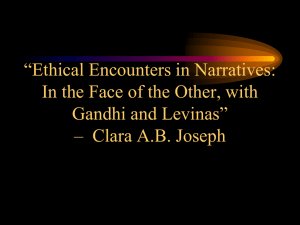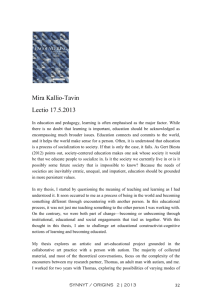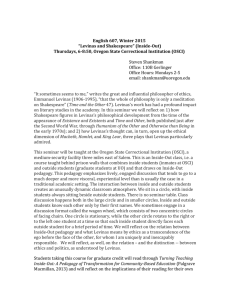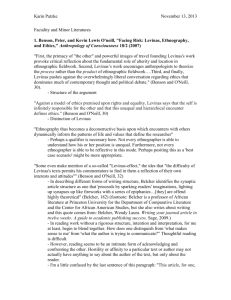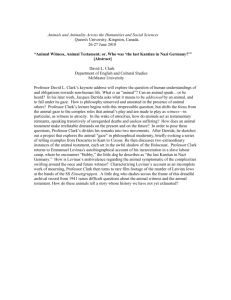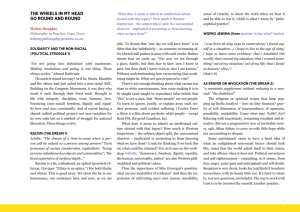Due to Levinas we experience the death of the Other as
advertisement
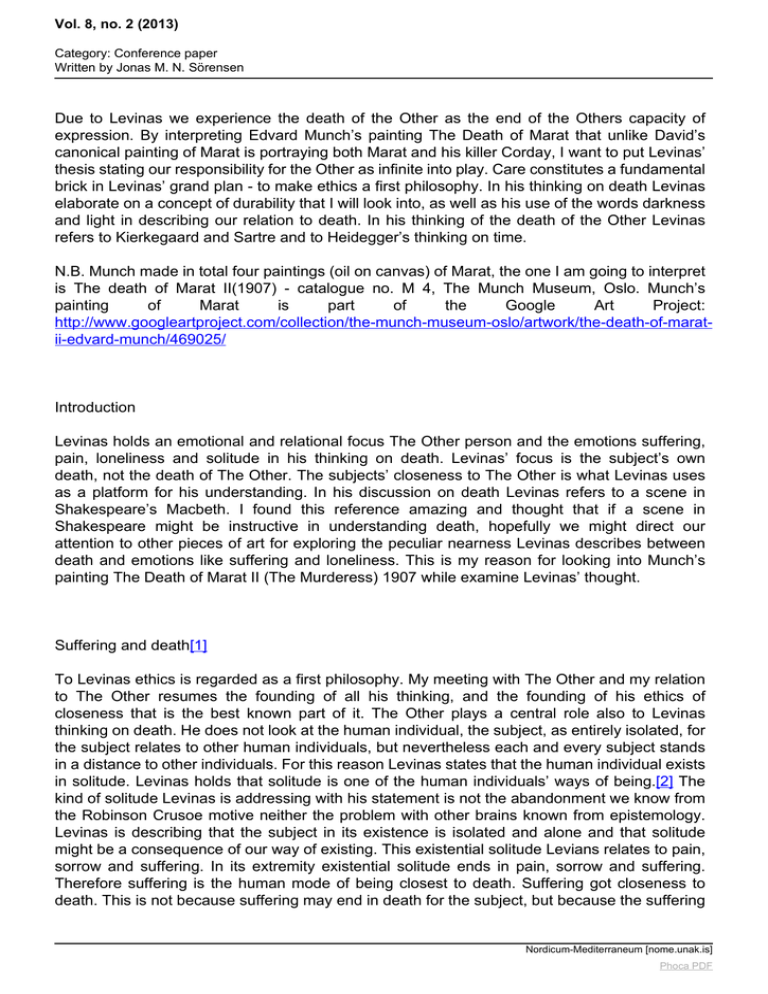
Vol. 8, no. 2 (2013) Category: Conference paper Written by Jonas M. N. Sörensen Due to Levinas we experience the death of the Other as the end of the Others capacity of expression. By interpreting Edvard Munch’s painting The Death of Marat that unlike David’s canonical painting of Marat is portraying both Marat and his killer Corday, I want to put Levinas’ thesis stating our responsibility for the Other as infinite into play. Care constitutes a fundamental brick in Levinas’ grand plan - to make ethics a first philosophy. In his thinking on death Levinas elaborate on a concept of durability that I will look into, as well as his use of the words darkness and light in describing our relation to death. In his thinking of the death of the Other Levinas refers to Kierkegaard and Sartre and to Heidegger’s thinking on time. N.B. Munch made in total four paintings (oil on canvas) of Marat, the one I am going to interpret is The death of Marat II(1907) - catalogue no. M 4, The Munch Museum, Oslo. Munch’s painting of Marat is part of the Google Art Project: http://www.googleartproject.com/collection/the-munch-museum-oslo/artwork/the-death-of-maratii-edvard-munch/469025/ Introduction Levinas holds an emotional and relational focus The Other person and the emotions suffering, pain, loneliness and solitude in his thinking on death. Levinas’ focus is the subject’s own death, not the death of The Other. The subjects’ closeness to The Other is what Levinas uses as a platform for his understanding. In his discussion on death Levinas refers to a scene in Shakespeare’s Macbeth. I found this reference amazing and thought that if a scene in Shakespeare might be instructive in understanding death, hopefully we might direct our attention to other pieces of art for exploring the peculiar nearness Levinas describes between death and emotions like suffering and loneliness. This is my reason for looking into Munch’s painting The Death of Marat II (The Murderess) 1907 while examine Levinas’ thought. Suffering and death[1] To Levinas ethics is regarded as a first philosophy. My meeting with The Other and my relation to The Other resumes the founding of all his thinking, and the founding of his ethics of closeness that is the best known part of it. The Other plays a central role also to Levinas thinking on death. He does not look at the human individual, the subject, as entirely isolated, for the subject relates to other human individuals, but nevertheless each and every subject stands in a distance to other individuals. For this reason Levinas states that the human individual exists in solitude. Levinas holds that solitude is one of the human individuals’ ways of being.[2] The kind of solitude Levinas is addressing with his statement is not the abandonment we know from the Robinson Crusoe motive neither the problem with other brains known from epistemology. Levinas is describing that the subject in its existence is isolated and alone and that solitude might be a consequence of our way of existing. This existential solitude Levians relates to pain, sorrow and suffering. In its extremity existential solitude ends in pain, sorrow and suffering. Therefore suffering is the human mode of being closest to death. Suffering got closeness to death. This is not because suffering may end in death for the subject, but because the suffering Nordicum-Mediterraneum [nome.unak.is] Phoca PDF Vol. 8, no. 2 (2013) Category: Conference paper Written by Jonas M. N. Sörensen is unbearable. For Levinas the unbearable is represented by darkness; suffering is outside of all light, Levinas says. Death got something unknown to it and cannot take place in the light; it is like a hollow, according to Levinas. In Levinas thinking death will always be something unknown as expressed with darkness as a metaphor. But the subject does not find its relation to death inside of itself. Levinas holds that the subject relates to death as to a mystery. In line with the thinking of ethics as a first philosophy, and his thinking on The Other, Levinas understand the subject’s relation to death through the subjects relation to The Other. By this Levinas separates from for example Heidegger, Sartre and Kierkegaard whom all thinks that death gets into the selfhood of the subject and individuates it. Levinas challenge their position. For Levinas the subjects do not relate to death by its relation to nothingness like Heidegger[3], Sartre and Kierkegaard holds. A fundamental point in Levinas philosophy is that the subject’s responsibility for The Other is infinite. In meeting The Other the subject relates to infinity in much the same way as when relating to death, I will get back to this point later. Parmenides said that death did not concern him. When he existed, death did not, and when death existed, he did not. Levinas thinks that this is a far too simple rejection of the mystery of death. According to Levinas death is something on the outside of the subject, something never graspable for the subject. But through suffering, sorrow and pain the subject is capable for itself and in itself to get closeness to death. Not only the subjects own, but also The Others suffering, sorrow and pain might give the subject closeness to death. Levinas holds that the subject’s relation to death got similarities to the subject’s relation to The Other. This relation can be described by saying that both death and The Other are something outside the subject, something unknown. Levinas makes clear that the suffering and pain he wants to address by his statements on death is the physical pain and the physical suffering, not what he calls the moral pain. About moral pain Levinas says that it is possible to remain dignity and innocence while suffer, and simultaneously be free. Levinas wants to investigate the physical pain and how it relates to loneliness. He thinks that suffering is something more than what shows to us through our suffering. This “something” is hidden and veiled, in a definite sense not known to the subject and something that the subject is not. Suffering remains in darkness, according to Levinas. It is something more to suffering than what the subject does not know, and that the subject is. The darkness belongs both to suffering and to pain, they both lacks the clarity of the factual. Death cannot be known. In Levinas philosophy light is associated to joy, to all involvement and all attachment. All that can be knowledge to the subject got light. This includes every object reachable for the subject and absorbed by the subject, even if they remain in a distance and outside of the subject. The Nordicum-Mediterraneum [nome.unak.is] Phoca PDF Vol. 8, no. 2 (2013) Category: Conference paper Written by Jonas M. N. Sörensen objects of sensation and emotion might get out in the light and become knowledge for the subject. The subject makes the objects outside of it intelligible, and acquires knowledge about them. The objects might tread into the light, but death on the other hand will always remain in darkness together with suffering, pain and sorrow, according to Levinas. This lack of light should not be seen as negation. The lack of light in death in Levinas’ thinking is an expression of the unknowable in death. Through the insight that death itself is not suffering, sorrow or pain Levinas wants to narrow an understanding of death. In this the relations Levinas finds between the concepts suffering, sorrow and pain becomes crucial. Levinas tries to drag the concepts closer to the subject’s reality in his thinking. The unknown darkness in suffering, sorrow and pain is tried used in his understanding of death. This is Levinas’ way of trying to get into the darkness of death. Said in another fashion; the concepts suffering, sorrow and pain got something in common. We find a part of death inside of them, and are getting closer to an understanding of death by getting a clearer picture of the relation between these concepts. But some important differences between death and suffering, sorrow and pain must be pointed out; for the subject death will always be the future. It is never here. To Levinas our inability to grasp death means that the end of the subject’s virility and heroism are out of reach too. To illustration this Levinas refers a scene from Shakespeare. It is the scene where Macbeth understands that the end is near, where Wood comes marching and Macbeth tells Macduff his malediction. In Levinas’ reading this marks the end of Macbeth’s (and the subject’s) virility and heroism. Dying on canvas I decided to go to a painting by Edvard Munch in trying to understand death according to Levinas. In Munch’s paintings we often find personifications of abstract ideas in the shape of emotions like love, loneliness, shame, anxiety, jealousy and death. One aspect of Munch’s art is Munch’s great ability to express common emotions, and this is my reason for taking Munch as my starting point for reflecting on Levinas’ concept of death. Munch painted a murder. The picture of the murdered and the murderer gives opportunity to reflect on death, also in Levinas’ understanding of it. I think about the darkness Levinas finds in death, and – even though in quite another fashion – in suffering, sorrow, pain and solitude. Munch stayed at Warnemünde in 1907, and in the paintings from there his own experiences is the theme like in many of his other paintings. In the Warnemünde paintings some specific negative emotions are expressed in all their commonness.[4] With powerful and clearly marked horizontal and vertical strokes Munch builds up plains in these pictures, and to a great extend in the picture I have picked out. It gives a small hypnotic effect. In my view Munch’s emotional focus got affinity to Levinas’ thinking on death. Levinas thinks about emotions he describes as having a common ground, and a relation to death. In Munch’s paintings from the early twentieth century, and to a large extent the pictures from the exhibition in Prague 1905, Munch focus on Nordicum-Mediterraneum [nome.unak.is] Phoca PDF Vol. 8, no. 2 (2013) Category: Conference paper Written by Jonas M. N. Sörensen painting his own emotions and experiences.[5] If we look at the totality of Munch’s production one usual opinion would be to describe him as a psychological painter with expressionistic preferences, and one phase of his production is often given the label symbolism. In the following I want to look into the tension between the two characters in one of his painting. I want to take a closer look at his painting The Death of Marat II (The Murderess), 1907. The most famous painting of Marat is Jacques-Louis David’s canonical painting from 1793 that dwells with Marat’s suffering. David’s focus on suffering cannot without question be transferred into Levinas’ thinking on suffering and death, where darkness plays an important role, or in Levinas’ statements like the ungraspable quality of death and suffering or something not knowable or not to be an object to our understanding. Levinas’ thought might have something to it anyhow, for if we look into David’s painting of Marat it is my impression that a feeling of sympathy might strike us, and probably the thought that an understanding of Corday’s action is hard to find. Corday was Marat’s murder, but she is not part of David’s painting. By this we can say that death becomes something ungraspable, something other than the knowable. In Munch’s version of this motive The Death of Marat II (The Murderess), 1907, we can see how Corday whom murdered Marat stands as a column in the room after the murder have taken place. Munch has placed Marat on his bed. This murder by knife was no accident, not an impulsive action. Corday does not look frightened where she stands in the foreground of the picture. When we see her she gives an impression of some kind of inner silence that has sunken into her. At the same time on a concrete level Marat lays in darkness. Most of all his face is placed in darkness. This darkness makes a strong contrast to Corday that is standing in the light. Munch painted Corday so that her feet are pointing a little bit outwards. She does not look like she is resting on her feet as she stands in this particular lightning. On the contrary it seems like he strives upwards in the vertical axis of the picture. We can find other issues contrasting the factual; at the canvas we do not find the paper where Marat wrote down the names of the Girondines he got from Corday, the names that was Corday’s excuse for visiting Corday with the assassination as a hidden agenda. Contrary to facts and back in Levinas’ thinking I would like to look at this painting and think through Levinas’ proposal that sorrow, pain, suffering and death got something in common. Munch’s painting should be seen as something symbolic, but Munch did not take a scene of fiction as his starting point. Death is something hidden, something dwelling in darkness, says Levinas. The painting on the other hand is something very direct and clear. A painting is something very showing, something displaying. Munch’s painting of Marat gives an impression of something almost shameless, like Munch want us to be ashamed by looking at it. As if it shows something we in fear should turn away from, precisely something shameless. At the same time, this painting is wistful. The painting is demonstrative too, like it tells us; this is something to be seen, this shall be seen. The painting got an opening to something we would consider as hidden and veiled, but that Munch drags into the light. Corday should be seen. Nordicum-Mediterraneum [nome.unak.is] Phoca PDF Vol. 8, no. 2 (2013) Category: Conference paper Written by Jonas M. N. Sörensen Is it while standing in front of a painting like this good reason in Levinas opinion that death remains in the darkness? Yes to some extent it is, Marat is laying in the background and in the darkness, we cannot see the details of his face. He is dead. Marat is kept out from us the living by Corday who stands in the light in the foreground. Does Corday feel guilt or regret? Is it a standstill in a boundlessly cool slyness we are given the opportunity to have a look at? It says that Corday surprised Marat and strokes him straight in the hart. To get back to Levinas firstly I would like to comment on the question about guilt; Levinas holds the imperative “Thou shalt not kill” as the first premise, the grounding premise in his philosophy. He would not have any sympathy or understanding to offer Corday, but reject and condemn this action in accord to his starting point in the responsibility of The Other.[6] Levinas regards the subject’s responsibility to The Other as infinite. Levinas condemns all violence and every murder. In an interview in 1993 Levinas points out very clearly that the core of justice is the demand never to regard The Other as mean[7], like we know this position from Kant’s categorical imperative. It might be possible to go to the historical facts here and argued that Marat under the white terror when the murder took place was about to send thousands of humans to the scaffold. The death of The Other affects me into my identity as a responsible I, says Levinas. It affects my, as he says, not-substantial identity and my endless responsibility. The death of The Other affects my identity as me. The death of the other is neither a second-hand experience nor a privileged death experience. The death of The Other changes the subject in itself according to Levinas. It repeal myself as the same, it creates repeal into my own self. The self that I am is not longer the same. In thoughts like these Levinas is closing in on Heidegger’s view on death. Heidegger said that being-towards-death got an anxiety leading Dasein into proper (eigentlich) being. Dasein gets into a reflection of its selfhood. But in Heidegger Levinas miss an affinity for the subject’s relation to the death of The Other and the meaningfulness of the death of The Other. For Levinas the death of The Other is a message with a meaning that changes the subject. It is not an experience for the subject, but it is an exceeding that changes the subject’s relation to itself. For the subject it seems like an influence, but at the same time as passivity, it is like an influence of something incomparable. The death of The Other is the influence of something not present, something more intimate than any intimacy, Levinas says.[8] If we should take these insights with us back to Munch’s painting, we would have to look for guild or regret in Corday. It is important to emphasis that Levinas’ statements are not meant for the case of murder, but anyhow; it seems like Corday have reached some kind of silence and tranquility in standing in the foreground of the picture. Time and Death The Death of Marat II (The Murderess) shows a sequence of time with presence, past and future and it is possible to recreate a sequence of actions. What we can call the transitivity of Nordicum-Mediterraneum [nome.unak.is] Phoca PDF Vol. 8, no. 2 (2013) Category: Conference paper Written by Jonas M. N. Sörensen the painting can be connected Levinas’ thesis holding that death will always be the future. Death is never now, as long as the subject lives death is future. In addition to this death marks the end of the subject’s virility and heroism, as the scene with Macbeth and Wood illustrates in Levinas’ thinking. In the picture Marat is laying on his bed. Corday is standing in the foreground in the light. In the foreground of the painting Corday gathers future, present and past in a thoughtful way. It seems like Corday has reached some kind of clarity and tranquility in the aftermath of her action. We who look at the painting are given the impression of the very dramatic moment of the killing as if it is the present. We know the peaceful past represented by Marat alone in his home. Seen in relation to the title The Death of Marat II (The Murderess) we will have to consider the picture itself as if it is the future, for the painting shows us Marat lying on his bed, Marat is already dead. Another way reading a dimension of time into the painting could be to say that Marat lay in a shadow in the pictures background, and that Corday stand in the foreground in the light. Marat might be seen as past because he represents something Corday has left behind. The murder has already taken place. The murdered is placed behind Corday who seeks out of the picture and upwards into the light. By seeking out and upwards Corday is in motion into the future. Corday ends Marat’s virility. The action in itself we can call a now. Afterwards Corday stands in the room, looking introspective. The painting gives the action a limiting frame, and Corday becomes past, present and future, the three concepts describing the subject’s relation to time. Are Corday as she stands in the foreground lonely? Her calmness after the murder gives us an impression of solitude. It gives meaning to call Corday lonely. She murdered Marat, and the companionship they both where part of when she came to him do not exist anymore. Levinas finds a connection between knowledge and loneliness in his thinking of death. Levinas says on knowledge that is holds some of the qualities of the light; both light and knowledge eats what is unique and outstanding.[9] Knowledge got a universality that contrasts the particularity of the subject in its loneliness. Back on the canvas it is clear and very easy to see Corday as a vertical in the foreground of the picture surface, and as a great contrast to the powerful horizontal of Marat in the background of the surface. This is only one of the contrasts in the painting, most important of them are; life, death, light and darkness. It is not like Levinas thinks the relation between knowledge and death as if the light related to knowledge negates the darkness surrounding death. In the picture Corday stands in the light and looks calm, and Marat lay in darkness and is death, in addition; Corday is lonely. To Levinas solitude is absent of time. The time is not something for the isolated subject, but something that must be seen as part of the subject’s relation to The Other. This deepens the abilities time offers loneliness, in Levinas’ view.[10] Marat’s face lay in the darkness, and darkness is Levinas central metaphor on death. Marat looks death and peaceful. We should say that this seems to be the case, for Marat’s face got a dark and seemingly bloody color. The sheet of the bed is bloody, and the one arm of his hangs Nordicum-Mediterraneum [nome.unak.is] Phoca PDF Vol. 8, no. 2 (2013) Category: Conference paper Written by Jonas M. N. Sörensen listless down against the floor. We might call the picture peaceful, but Marat’s face lay in the darkness. Levinas says that when someone dies, their face becomes a mask, and that the death person’s expression and ability to expression fades away.[11] * Levinas clams death makes the subject’s activity to passivity, and that death shares this ability with suffering. Marat suffered and is dead. With his painting Munch transfers the murder into symbolism and the subject’s relation to own death into symbolism and timelessness. Munch moves Marat into death by placing his body so that it point inwards into the picture, away from us that are looking at it and away from Corday. About suffering Levinas holds that it does not give any room for redemption, escape or withdrawal. Suffering is a crucial part of being. At the same time suffering and death shares the quality of not being translatable into the concepts of light, Levinas says. About death Levinas says that it by being unknown cannot move into a relationship to the subject that takes its place in the light. Levinas underscores that only the one being so lonely that he has suffered, and thereby got an understanding of how suffering is related to death, is able to see The Other as an opportunity. This rather strong statement might be met by objections like that we are still among our fellows when we suffer, or it is at least possible to be; for example when we sit by the bed of someone we are fond of who is suffering at the hospital, someone very ill. But, this is in fact outside of Levinas’ focus. Levinas is describing the one subject’s death, suffering and pain. In suffering the subject reach the limit of the possible, according to Levinas: “It [the subject] finds itself enchained, overwhelmed, and in some way passive. Death is in this sense the limit of idealism.”[12] Levinas’ holds that death’s very existence is made of alterity, and that the subject’s solitude is not confirmed by death but broken by it. This is the reason why the subject’s relation to The Other got aspects of the subject’s relation to death in it. Levinas says: we recognize The Other as resembling us, but exterior to us; the relationship with The Other is a relationship with mystery. The Other’s entire being is constituted by its exteriority, or rather its alterity. At the same time both death and The Other represents a way out of solitude for the subject. The similarities Levinas finds between the subject’s relation to death and the subject’s relation to The Other can be expressed by saying that both relationships are relations to infinity. Levinas sites Macbeth’s reply when he understands that Wood is matching against him, and that he is going to die: “Ring the alarm-bell!...” Death is the subject’s limit of suffering, but at Nordicum-Mediterraneum [nome.unak.is] Phoca PDF Vol. 8, no. 2 (2013) Category: Conference paper Written by Jonas M. N. Sörensen the same time it makes the subject’s finitude to something heroic and virile in Levinas eyes, for even if Macbeth realize that he are going to lose the battle he do want to fight Wood. The future of Death is not the subject, Levinas says. To the subject death is passivity. Knowledge stands against this. Knowledge transforms passivity to activity; something treads into the light. To die is without striving. Dying is future for the subject, but the future in dying cannot be seen as time. If it should it would have to be present, and it never is for the subject. Related to this Levinas says something noteworthy about his concept totality: “In the totality of the historiographer the death of the other is an end, the point at which the separated being is cast into totality, and at which, consequently, dying, can be passed through and past, the point from which the separated being will continue by virtue of the heritage his existence had amassed… What “still remains” is totally different from the future that one welcomes, that one projects forth and in a certain measure draws from oneself. For a being to whom everything happens in conformity with projects death is an absolute event, absolutely a posteriori, open to no power, not even to negation… the non-reference to the common time of history means that mortal existence unfolds in a dimension that does not run parallel to the time of history and is not situated with respect to this time as an absolute.”[13] By this it seems clear that the time of the historiographer and the time of the subject are different. In the painting Corday has murdered Marat, but does she know what death is because of this? Levinas says that what death got in common with suffering and pain is something more than what shows itself to us through our suffering. Our suffering got something hidden and veiled to it, something that we are not. This quality in suffering that we do not see, and that is different from us is part of death. Our ability to get through even the greatest pain, suffering gets from death, says Levinas. Back on the canvas Marat lay passively in the darkness on his bed. Marat is not longer a subject, and our relation to him is no longer a possibility. Marat is dead. Levinas / Munch / Death – towards a conclusion As we have seen, Levinas holds that it is possible to come closer to an understanding of the darkness in death through an understanding of the death of The Other. If we do we will see how emotions like suffering and pain relates to death. In his descriptions of the death of The Other and the emotions related to it, Levinas refers to Shakespeare. Thereby an opening into artistic formulations of the death of The Other is done. We might use artistic interpretations when trying to understand the death of The Other the way Levinas does. My interpretation of Munchas painting is only one of many possible interpretations, of Munch’s painting as well as of Levinas’ thinking on death. It gives a view of Levinas’ way of thinking. Thereby it is possible to do the subject’s relation to The Other to something more common. At the same time an Nordicum-Mediterraneum [nome.unak.is] Phoca PDF Vol. 8, no. 2 (2013) Category: Conference paper Written by Jonas M. N. Sörensen understanding of death becomes something more concrete than a description of the emotions of The Other. By making the death of The Other into an object of our aesthetic experience we are able to come closer to the emotions of The Other, emotions closely related to death according to Levinas. [1] I would like to express my most kindly thanks to Dr. Helgard Mardt at The University of Oslo for thoughtful comments on an earlier draft of my paper. [2] This presentation of Levinas thinking on death builds to large extends on the third of the four lectures Levinas gave at Collège philosophique de Jean Wahl in Paris in 1946 and 1947. Emmanuel Levinas (1987): Time and the Other. Pittsburg: Duquesne University Press, pp.67-79, for the theme solitude see p. 42 ff. [3] Martin Heidegger (1962): Being and Time. Oxford: Blackwell. § 49, p. 292. [4] Sissel Biørnstad (ed.) (1999): Munch og Warnemünde.Oslo: Munch-museet Labyrinth Press, p. 51. [5] Sissel Biørnstad (ed.) (1999): Munch og Warnemünde. Oslo: Munch-museet Labyrinth Press, p. 123. Nordicum-Mediterraneum [nome.unak.is] Phoca PDF Vol. 8, no. 2 (2013) Category: Conference paper Written by Jonas M. N. Sörensen [6] Emmanuel Levinas (1969): Totality and Infinity. Pittsburg: Duquesne University Press, p. 199. [7] Jodalen and Vetlesen (1997): Closeness an ethics. Oslo: Scandinavian University Press, p. 54. [8] Emmanuel Levinas (2000): God, Death, and Time. California: Standford University Press, p. 12. [9] Emmanuel Levinas (1987): Time and the Other. Pittsburg: Duquesne University Press, p. 65. [10] Emmanuel Levinas (1987): Time and the Other. Pittsburg: Duquesne University Press, p. 40, 57. [11] Emmanuel Levinas (2000): God, Death, and Time. California: Standford University Press, Nordicum-Mediterraneum [nome.unak.is] Phoca PDF Vol. 8, no. 2 (2013) Category: Conference paper Written by Jonas M. N. Sörensen p. 12. [12] Emmanuel Levinas (1987): Time and the Other. Pittsburg: Duquesne University Press, p. 71. [13] Emmanuel Levinas (1969): Totality and Infinity. Pittsburg: Duquesne University Press, p. 56. Nordicum-Mediterraneum [nome.unak.is] Phoca PDF Powered by TCPDF (www.tcpdf.org)
